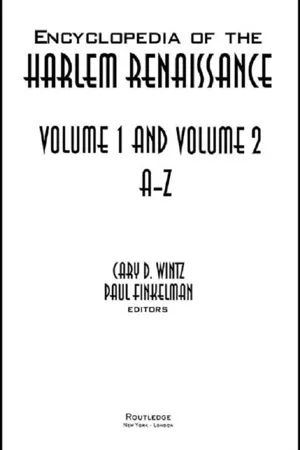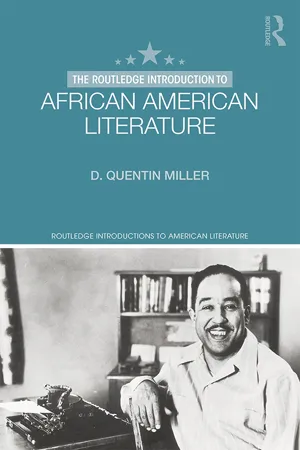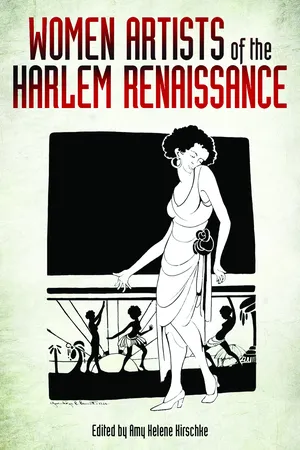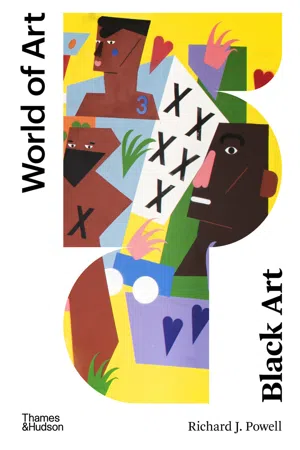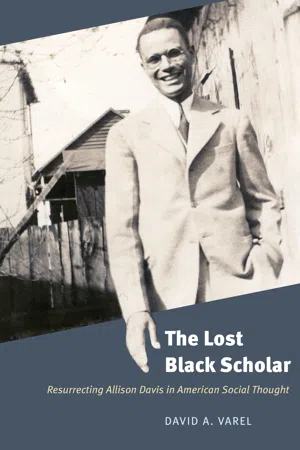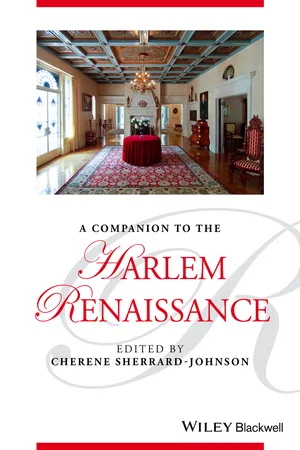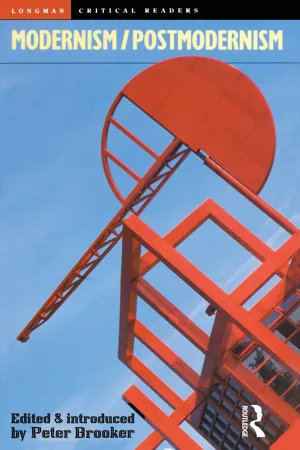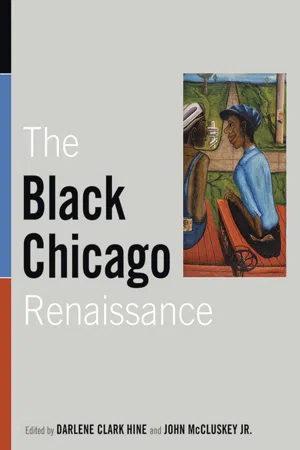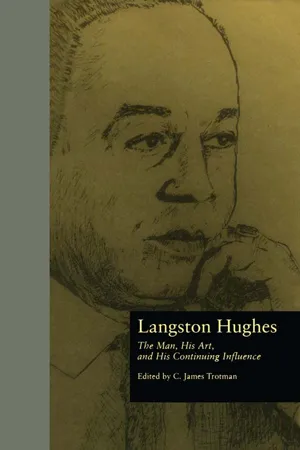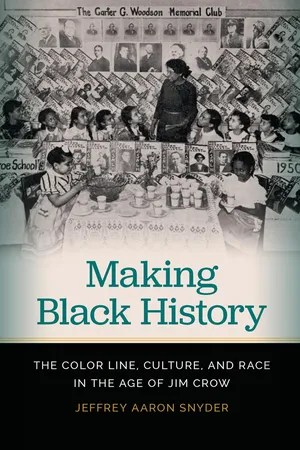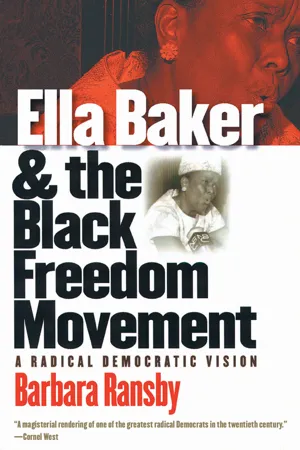History
Harlem Renaissance Art
The Harlem Renaissance was a cultural, social, and artistic explosion that took place in Harlem, New York, during the 1920s. It was a time of great artistic achievement, particularly in literature, music, and visual arts. Harlem Renaissance art reflected the experiences and expressions of African American life, and it played a significant role in shaping the cultural landscape of the United States.
Written by Perlego with AI-assistance
Related key terms
12 Key excerpts on "Harlem Renaissance Art"
- eBook - ePub
- Cary D. Wintz, Paul Finkelman, Cary D. Wintz, Paul Finkelman(Authors)
- 2012(Publication Date)
- Routledge(Publisher)
The visual arts of the Harlem Renaissance have long gone without the renown and attention given to the literature of the period. Indeed, the Harlem Renaissance is most often characterized as a specifically literary phenomenon fueled by racial demographic and cultural shifts from the American South to the North. In fact, the visual arts experienced a distinct and related renaissance beginning in the mid-1920s, inextricably tied to the era's writers and intellectuals, but also rooted in less-developed creative traditions and using an alternative set of inspirational sources. If writers such as Langston Hughes and Zora Neale Hurston were inventing a body of literature that valued black vernacular culture in reaction to a tradition from earlier black writers that had emphasized narratives of tragedy and uplift, then the painters, sculptors, and photographers of the Harlem Renaissance were reacting to a tradition that had been very nearly silent on the subject of black life, even from an earlier generation of black artists. If playwrights and poets of the renaissance mined working-class life for inspiration, visual artists were encouraged to look to African art forms.The visual arts of the Harlem Renaissance—seen in the work of the painters Aaron Douglas, Palmer Hayden, and Hale Woodruff; the sculptors Meta Warrick Fuller and Augusta Savage; and the photographer James Van Der Zee, among others—represents the earliest moment when significant numbers of black artists turned to black life as legitimate subject matter. This fact distinguishes their achievements from those of their writer colleagues whose work followed and built on earlier race-based literary traditions. Moreover, many visual artists attempted to represent African American life through a prism of African-inspired European modernist art in seeking to define a racially identifiable style of art. The task with which these artists were charged was, therefore, a tremendous one: In a vacuum of “positive” black imagery, they were asked to invent a style that paid homage to a legendary ancestral past from Africa while also representing that which was new, modern, folk-based, urban, and above all honored black life. That some of these artists generated controversy, became disillusioned, were later criticized for mediocrity, were forgotten, or left the arts altogether is not surprising. What is surprising is the considerable success they enjoyed and the degree to which their work was embraced and supported. Their successes are an enduring index of how much their work was needed. - D. Quentin Miller(Author)
- 2016(Publication Date)
- Routledge(Publisher)
4 The Era of the Harlem RenaissanceThe period known as the Harlem Renaissance (also called the “New Negro” Renaissance) is mostly associated with the 1920s, though its beginnings can be traced to the years just prior, and some of its spirit continued to exist in the years just after, until the Great Depression brought about a new set of issues that further changed the nature of African American literature. During the 1920s, an unprecedented amount of black writing was published and accepted by the white literary establishment, promising not only a better future for race relations, but, equally importantly, a new sense of black race pride. F. Scott Fitzgerald dubbed the 1920s “The Jazz Age,” and the development of that musical form is central to other African American cultural developments at the time. But although some of the architects and builders of the Renaissance wanted it to be seen as a purely artistic movement, it is evident that the literary tug-of-war of the Reconstruction era between sociopolitical thought and art-for-art’s-sake continued.The word “renaissance” connotes a rebirth, but it also refers to a focused period of extraordinary cultural production. The Harlem Renaissance fulfills both connotations: a new optimism replaced the mood of cultural uncertainty that characterized black America in the late nineteenth and early twentieth centuries, and it manifested itself in a spectacular artistic outburst. There is some debate about whether or not the Harlem Renaissance was a spontaneous outpouring of art or a socially and politically manufactured phenomenon: a conscious attempt to atone for the failures of Reconstruction. David Levering Lewis writes, “The Harlem Renaissance was a somewhat forced phenomenon, a cultural nationalism of the parlor, institutionally encouraged and directed by leaders of the national civil rights establishment for the paramount purpose of improving race relations in a time of extreme national backlash, caused in large part by economic gains won by Afro-Americans during the Great War” (xiii). Nathan Irvin Huggins begins his essential study of the movement with the observation, “It is a rare and intriguing moment when a people decide that they are the instruments of history-making and race-building” (3).- eBook - ePub
- Amy Helene Kirschke(Author)
- 2014(Publication Date)
- University Press of Mississippi(Publisher)
So, what was the Harlem Renaissance? The simple answer is that the Harlem Renaissance (or the New Negro movement, or whatever name is preferred) was the most important event in twentieth-century African American intellectual and cultural life. While best known for its literature, it touched every aspect of African American literary and artistic creativity from the end of World War I through the Great Depression. Literature, critical writing, music, theater, musical theater, and the visual arts were transformed by this movement; it also affected politics, social development, and almost every aspect of the African American experience from the mid-1920s through the mid-1930s.But there was also something ephemeral about the Harlem Renaissance, something vague and hard to define. The Harlem Renaissance, then, was an African American literary and artistic movement anchored in Harlem, but drawing from, extending to, and influencing African American communities across the country and beyond. We date it roughly from the end of the First World War through the Great Depression, but its roots extend well before the war and its legacy continued many years beyond the 1930s. It had no clearly defined beginning or end, but emerged out of the social and intellectual upheaval in the African American community that followed World War I, blossomed in the 1920s, and then faded away in the mid- to late 1930s and early 1940s.Likewise the Harlem Renaissance has no single defined ideological or stylistic standard that unified its participants and defined the movement. Instead, most participants in the movement resisted black or white efforts to define or narrowly categorize their art. For example, in 1926 a group of writers, spearheaded by writer Wallace Thurman and including Langston Hughes, Zora Neal Hurston, and artist Aaron Douglas, among others, produced their own literary magazine, Fire!! One purpose of this venture was the declaration of their intent to assume ownership of the literary Renaissance. In the process they turned their backs on Alain Locke and W. E. B. Du Bois and others who sought to channel black creativity into what they considered to be the proper aesthetic and political directions. Despite the efforts of Thurman and his young colleagues, Fire!! fizzled out after only one issue and the movement remained ill defined. In fact, this was its most distinguishing characteristic. There would be no common literary style or political ideology associated with the Harlem Renaissance. It was far more an identity than an ideology or a literary or artistic school. What united participants was their sense of taking part in a common endeavor and their commitment to giving artist expression to the African American experience. If there was a statement that defined the philosophy of the new literary movement it was Langston Hughes’s essay, “The Negro Artist and the Racial Mountain,” published in the Nation - eBook - ePub
Black Art
A Cultural History
- Richard J. Powell(Author)
- 2022(Publication Date)
- Thames and Hudson Ltd(Publisher)
This brief account of the term “Negro Renaissance”—and the more frequently employed “Harlem Renaissance”—is useful if only as a demonstration of how, over time and depending upon the operative disciplines and methodologies employed, the significance of the concept has subtly shifted. In these several transformations from a literary term to a generic designation, from a generic designation to a visual arts phenomenon, and from a cultural motif to one defined by race, culture, and, most significantly, location, “Harlem Renaissance” has come to define the “New Negro” movement as a broad-based, multidisciplinary program, concentrated in New York’s black community. The problem is that the term “Harlem Renaissance” is wanting as an accurate yet elastic description of the levels and range of black creativity in the 1920s and early 1930s.Before entering further into a critique of the term, it is worthwhile to look at the historical and cultural factors that have led some scholars to locate this regenerative impulse in Harlem. Of primary importance was Harlem’s large and growing black population. In 1925, it numbered about 175,000; by 1930, with steady migration from the southern States and immigration from the Caribbean and other parts of the black diaspora, it had expanded to over 200,000, making it the largest African American urban community of its kind. The new arrivals found advocates for their collective interests among several major black organizations with headquarters there. The NAACP, the National Urban League, the Universal Negro Improvement Association, and literally dozens of churches, fraternal organizations, sororities, social clubs, weekly newspapers, and businesses helped define and shape this Harlem-based “Renaissance.”Harlem was, of course, a racially and culturally distinctive community within New York City, yet one should resist the temptation to isolate Harlem’s fame and fortunes in the 1920s and early 1930s from those of greater Manhattan. New York City’s flamboyant Mayor in the second half of the 1920s, Jimmy “Beau James” Walker, encouraged the economic development of cultural forces in the city—radio broadcasters; book, magazine, and newspaper publishers; concert promoters; Broadway producers; song writers; cabaret owners; and various other entrepreneurs, legitimate and underworld—who, in their own way, helped to stimulate the vogue for Harlem. The roster of Harlem-based writers, actors, and musicians whose talents were advanced by these assorted cultural forces in New York City was a Who’s Who - eBook - ePub
The Lost Black Scholar
Resurrecting Allison Davis in American Social Thought
- David A. Varel(Author)
- 2018(Publication Date)
- University of Chicago Press(Publisher)
While students at Hampton and other black colleges throughout the country were protesting administrative paternalism, the nation’s most influential black leaders were launching their own more visible protests—political, cultural, and otherwise. Harlem, the black ghetto in New York City, emerged as the capital of black culture in these years. Marcus Garvey, the Jamaican Pan-Africanist who attempted to orchestrate a Back to Africa movement, powerfully influenced the black masses with his message of racial pride and Black Nationalism. He did this in an era when many African Americans were attempting to integrate into white society by hiding their African heritage, often straightening their hair and dyeing their skin white.Among many black intellectuals, too, integration rather than separation carried the day during the 1920s.5 The integrationist program did, however, take new form in the twenties through the arts. Various terms arose to conceptualize this cultural experimentation, especially the “Harlem Renaissance” and the “New Negro Movement.” Befitting an era when Americans applied the adjective new to all parts of society, “New Negro” captured the sense of novelty characterizing African American life in urban centers such as Harlem.The Renaissance emerged as an important, if limited, intellectual movement: “a somewhat forced phenomenon, a cultural nationalism of the parlor.”6 The movement was guided by the “Talented Tenth,” which comprised approximately ten thousand affluent race leaders among a population numbering over ten million. Race leaders carefully orchestrated the movement through the NAACP’s Crisis and the National Urban League’s Opportunity magazines. The idea was that because “the roads to the ballot box, the union hall, the decent neighborhood and the office were blocked,” Renaissance leaders looked to the arts and letters to demonstrate black equality.7 In their fight over the politics of culture, they supplanted racist images of the “Old Negro,” who was backward and simplistic, with representations of the “New Negro,” who was modern and sophisticated.8 This often entailed portraying only the more dignified, progressive side of black life as they saw it and suppressing those elements that whites could use to prove black incivility.Like any movement, the Renaissance evolved over time. Early on, after World War I, white Greenwich Village radicalism—rebelling against Victorianism, entrenched scientific and popular racism, widespread anti-immigrant sentiment, far-reaching antiradicalism, the vigorous suppression of dissent, and white supremacy—encouraged the ideal of a “trans-national” America in which Americans celebrated the nation’s racial and ethnic diversity.9 That notion spread in the twenties, as many intellectuals perceived sterility within WASP culture. Seemingly overnight, white thinkers looked anew upon black people, finding in their oppression and African roots a vibrancy lacking within larger society. If their romanticizing of black culture was unwelcome, their support for black artistic expression was not.10 - eBook - ePub
- Cherene Sherrard-Johnson, Cherene Sherrard-Johnson(Authors)
- 2015(Publication Date)
- Wiley-Blackwell(Publisher)
Part IV InterracialismPassage contains an image
20 Authenticity and the Boundaries of Blackness
J. Martin FavorAs scholars and students of the Harlem Renaissance, we already come to the subject with the presupposition that we are looking into African American literature. Although that seems obvious on the surface, when we delve further beneath the surface of things, the questions of what and who constitute African American culture quickly become relatively complex. While it may seem obvious or intuitive as to what qualifies as black art or a black artist, it is also important to note that much of artistic production of the Harlem Renaissance struggled with these notions either implicitly or explicitly.If we think about the notion of “renaissance” itself, the idea of “rebirth” clearly takes center stage. Indeed, it is not specifically or only the rebirth of the geographical space of Harlem, New York that we are considering; rather, we are taking up the ways in which Harlem stands in metonymic relationship to African American people and culture. In what ways is black America reborn during this period? How does the rebirth represent a difference from the generations that have come before? How are we to evaluate which of those notions of African American identity are better, more accurate, or more authentic?By the same token, if we forget for a moment the idea of the Harlem Renaissance and consider instead the idea of the New Negro Movement, the same kinds of issue emerge. Who was the “Old Negro” and what are the ramifications of a movement that self-consciously seeks to renew or recreate African American art and identity? Throughout the rest of this essay, my goal will be to examine the contexts out of which the struggle to redefine blackness emerged and to give a brief set of analyses of several major literary figures of the New Negro Movement. I will examine several implicit and explicit expressions of what we might call “authentic blackness.” That is, I will explore literary portrayals that we might think of as representative of African Americans as a group, and ask whether such representational strategies present more problems than they might purport to solve. I also want to consider the ways in which we continue to feel a need to define the African American subject in terms of authenticity and how such definitions mold our understanding of the Harlem Renaissance era. - Lindon Barrett, Justin A. Joyce, Dwight A. McBride, John Carlos Rowe(Authors)
- 2013(Publication Date)
- University of Illinois Press(Publisher)
CHAPTER 5 Modernism and the Affects of Racial BlacknessIn the introduction to the prose collection A Renaissance in Harlem, Lionel Bascom briefly describes the cultural significance of the Harlem Renaissance and its program, stating that “the spiritual, social, and literary fervor that raced through Harlem during these years could be called the greatest period of self-discovery in African-American history after the Civil War and before the start of the Civil Rights era of the 1960s.”1 He writes further that the participating artists “used Harlem’s growing popularity as a unique opportunity to do what reconstruction after the Civil War had not done—create a positive public image of blacks as thinking, creative human beings in American society. It was a noble effort. In their widely read essays, novels, plays, and newspaper articles, this well-meaning group set out to kill pernicious stereotypes of black folks.”2 George Schuyler and Langston Hughes famously address this issue of the cultural profile of African Americans in early-twentieth-century modernity in their essays “The Negro-Art Hokum” and “The Negro Artist and the Racial Mountain,” published in The Nation in 1926, at the height of the Harlem Renaissance. The essays dispute the specificity of African American culture and identity by considering the forms and meanings of contemporary social interactions, rather than primarily historical points of reference. Rather than assessing African American aesthetics foremost by the legacies and aftermath of U.S. enslavement, the essays articulate divergent attitudes toward the routinely measured advancement or progressiveness of the early twentieth century, sharing then the matter of modernity, but not necessarily the inclinations of modernism. The essays debate the nature or effect of African American participation in the quotidian world of the early twentieth century, so that, unlike the primary African American speculations of the eighteenth and nineteenth centuries and earlier, the propositional knowledge is the introjection of African Americans into the U.S. civic order, an introjection understood as more or less quotidian, confirming Bascom’s observations on the cultural success of the Harlem Renaissance, the broad proposition “of blacks as thinking, creative human beings in American society.” They contest the cultural upshot of the modern quotidian made clearly and increasingly literal and literary within the boundaries of “One Hundred and Tenth Street on the south; on the east, Lenox Avenue to One Hundred and Twenty-sixth Street, then Lexington Avenue to the Harlem River, and the Harlem River on the east and north to a point where it passes the Polo Grounds, just above One Hundred and Fifty-fifth Street; on the west, Eighth Avenue to One Hundred and Sixteenth Street, then St. Nichols Avenue up to a juncture with the Harlem River at the Polo Grounds,” as put by Schuyler in his critique of Harlem Renaissance writers.3- eBook - ePub
- Peter Brooker(Author)
- 2014(Publication Date)
- Routledge(Publisher)
What stirs inarticulately in the masses is already vocal upon the lips of the talented few, and the future listens, however the present may shut its ears'. I want to suggest that a complete expressive modernity was achieved only when the 'Harlem Renaissance' gave way to what might be called — following the practices of Anglo-American and British moderns — 'renaissancism'. By this term, I want to suggest a spirit of nationalistic engagement that begins with intellectuals, artists, and spokespersons at the turn of the century and receives extensive definition and expression during the twenties. This spirit is one that prompts the black artist's awareness that his or her only possible foundation for authentic and modern expressivity resides in a discursive field marked by formal mastery and sounding deformation. Further, I want to suggest that 'renaissancism' connotes something quite removed from a single, exotic set of 'failed' high jinks confined to less than a decade. It signals in fact a resonantly and continously productive set of tactics, strategies,and syllables that takes form at the turn of the century and extends to our own day. One of the most obvious cullings of renaissancism's fruits occurs in the thirties and situates itself firmly in accord with deformative possibilities inherent in The New Negros ' validation of the folk, or, the vernacular. Gone in the work of a poet like Sterling Brown is the felt necessity to produce only recognizably standard forms. What replaces this drive is an unashamed and bold dedication (a dedication that remains, for the most part, implicit in the sotto voce urgings of the Harlem twenties) to rendering the actual folk voice in its simple, performative eloquence. If a black, folk, national voice existed, the thirties seemed to realize that it was not far to seek - eBook - ePub
- Darlene Clark Hine, John McCluskey, Darlene Clark Hine, John McCluskey, Marshanda A. Smith(Authors)
- 2012(Publication Date)
- University of Illinois Press(Publisher)
We stand on top of the mountain free within ourselves. —LANGSTON HUGHES, “The Negro Artist and the Racial Mountain”Introduction
DARLENE CLARK HINEBeginning in the 1930s and lasting into the 1950s, black Chicago experienced a cultural renaissance that rivaled and, some argue, exceeded the cultural outpouring in Harlem. The Black Chicago Renaissance, however, has yet to receive its full due. This volume addresses that neglect. The Black Chicago Renaissance was unparalleled in many respects. Like Harlem, Chicago had become a major destination for black southern migrants. Unlike Harlem, it was also an urban industrial center. This fact gave a unique working-class and internationalist perspective to the cultural work that would take place there.The contributors to this Black Chicago Renaissance anthology analyze a dynamically prolific period of African American creativity in music, performance art, social science scholarship, and visual and literary artistic expression. Each author implicitly discusses forces that both distinguish and link the Black Chicago Renaissance to the Harlem Renaissance.1 New scholarship, to which this volume contributes, suggests that we are better served and our understanding of black culture significantly enriched by placing its modern development in a national and international context and by probing the histories of multiple (sequential and overlapping—Philadelphia, Cleveland, Detroit, Los Angeles, Memphis) black renaissances.2The “New Negro” consciousness with its roots in the generation born in the last and opening decades of the nineteenth and twentieth centuries respectively, replenished and watered by migration, and solidified into the creative force, the Harlem Renaissance in the 1920s, was destined to reemerge significantly transformed in the 1930s as the Black Chicago Renaissance.3 - eBook - ePub
Langston Hughes
The Man, His Art, and His Continuing Influence
- C. James Trotman(Author)
- 2014(Publication Date)
- Routledge(Publisher)
Langston Hughes & the Blues . Urbana: University of Illinois Press, 1988.- Wall, Cheryl A. “Poets and Versifiers, Singers and Signifiers: the Women of the Harlem Renaissance.” VirginiaLussier and KennethWheeler, eds. Women, the Arts, and the 1920s in Paris and New York . New Brunswick, NJ: Transaction Books, 1982.
Passage contains an image
Langston Hughes: Poetry, Blues, and Gospel—Somewhere to Stand
Steven C. TracyDOI: 10.4324/9781315861593-10The Greek mathematician and inventor Archimedes once said, “Give me somewhere to stand and I will move the earth.” Literary artists, too, must find their places to stand in order to move the earth. And certainly the best of them plant their feet where the ground seems to them to be most stable, especially when their mission is to move the firmament from the shoulders of Atlas onto their own, to provide some new, revolutionary, and mountainous foundation for our visionary dreams. In the midst of that Modernist revolution we know as the Harlem Renaissance or the New Negro Movement, there was a figure who sought to change the way we looked not only at art and African Americans, but also at the world. His vision was modernistic: experimental, both spontaneous and improvisatory and thoughtfully and carefully crafted, at times primitivistic, disjunctive, and cacophonous, rejecting artificial middle-class values, promoting emotional and intellectual freedom, and, above all, life- and love-affirming—self-affirming. And not only affirming of the African American self, though certainly Langston Hughes spent a lifetime climbing the racial mountain and living and affirming an African American self, but also affirming what RalphEllison called in Invisible Man - eBook - ePub
Making Black History
The Color Line, Culture, and Race in the Age of Jim Crow
- Jeffrey Snyder(Author)
- 2018(Publication Date)
- University of Georgia Press(Publisher)
Anthologies set the renaissance’s tone and elaborated its logic, stimulating intense debates about the nature of “Negro art” and the relationship between culture and race. The New Negro was only one of a flood of anthologies released in the renaissance era. Indeed it was during the 1920s and 1930s that scholars such as Woodson, Locke, and Benjamin Brawley assembled the first collections of African American music, literature, and drama, laying claim to a rich artistic heritage with roots in both Africa and America. Anthologies such as Negro Poets and Their Poems (1923), Book of American Negro Spirituals (1925), and Plays of Negro Life (1927) historicized “the Negro,” describing the development of African American art and explaining how it related to larger historical trends. As sources of “facts and inspiration,” they also provided a cultural background for the New Negro—a platform for the further development of African Americans as a collective group. 22 Locke, writing in 1926, averred that American culture comprised a “confederation of minority traditions.” 23 Historical investigation and analysis were the primary means to recover the African American minority tradition, a heritage that was distinctively black at the same time that it was wholly American. Chapter 4 (“The New Negro Goes to School”) demonstrates that the early black history movement and the Negro Renaissance did not simply run in parallel but intersected and combined in powerful and heretofore unacknowledged ways. The advent of Negro History Week in 1926 should be seen as a landmark development in the history of the renaissance, providing a critical foundation for the cultural awakening of African Americans as a people. 24 Negro History Week celebrations introduced black audiences across the country to renaissance art, ranging from the poems of Langston Hughes to the musical compositions of Harry T. Burleigh - eBook - ePub
Gender and American Culture
A Radical Democratic Vision
- Barbara Ransby(Author)
- 2003(Publication Date)
- The University of North Carolina Press(Publisher)
Harlem's new residents came not only from the farms and fields of the U.S. South, but also from Jamaica, Barbados, Antigua, Guyana, Trinidad, and, in smaller numbers, various parts of Africa. By 1930, 55 percent of all foreign-born blacks in the United States lived in Harlem. Among them were W. A. Domingo, Claudia Jones, Cyril V. Briggs, Otto Huiswood, Grace Campbell, and Richard Moore, all of whom became key forces in shaping Harlem's black left community from the 1910s through the 1930s. 10 Baker recalled fondly that Harlem during the years of the Great Depression was “a hotbed of radical thinking.” 11 The political and cultural rumblings of the late 1910s and early 1920s had infused a new spirit of resistance and intellectual energy into the community. The cultural revolution known as the Harlem Renaissance, the black pride movement led by the Jamaican-born Marcus Garvey, and the agitation and education carried on by a small group of black socialists known as the Harlem radicals had effectively re-colored and revitalized Harlem's political and cultural landscape a decade before Ella Baker's arrival. These developments, coupled with the economic suffering caused by the onset of the depression in 1929 and socialist rumblings increasingly heard around the world, laid the foundation for the “unprecedented explosion of protest activity” that occurred during the 1930s. 12 For Ella Baker and many others, Harlem was a politically and intellectually invigorating place to be. Intense political debates raged everywhere, spawning militant protests in the streets. There were rent strikes, picket lines, marches, street corner rallies, and the famous Harlem riot of 1935, which was triggered by an incident of alleged police brutality
Index pages curate the most relevant extracts from our library of academic textbooks. They’ve been created using an in-house natural language model (NLM), each adding context and meaning to key research topics.
